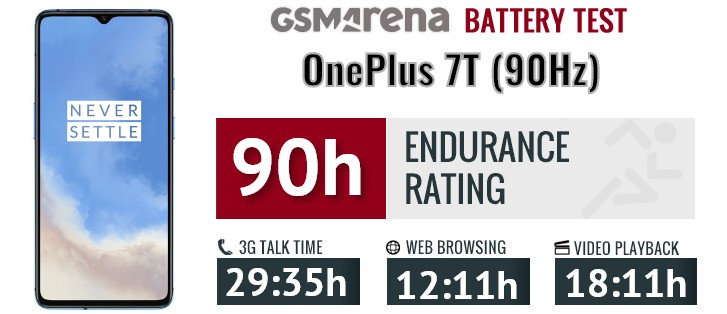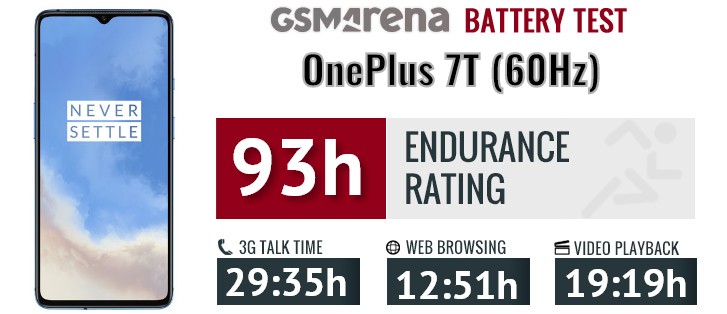OnePlus 7T review

Display
The best update on the OnePlus 7T is the 90Hz display, which OnePlus calls it the 'Fluid AMOLED display'. The other update was making it bigger. The screen is the same width as the 7, but it is now slightly longer and has a 20:9 aspect ratio. This also bumped up overall length of the phone by a few millimeters.

All aspects of the phone's UI evolve when they are viewed in 90Hz. Everything is far smoother and makes the interface feel quicker and snappier overall. The animations are also more immersive and the transitions are almost mesmerizing.
Of course, none of this is necessary since you won't see YouTube videos above 60 fps and it doesn't add any functionality to the phone, but playing Pokémon Go! in 90 fps is low-key kind of cool. Yes, only supported games will go above 60fps to make the best use of the high refresh rate but the list is growing longer.
The 7T's display has been updated with a brighter panel, but it keeps the same pixel density with a resolution of 2400 x 1080 px. In our testing, we found the OnePlus 7T to have flagship-worthy brightness with a maximum output of 743 nits. That's of course once you enable the adaptive brightness setting - with that toggled off, the display outputs a respectable 525 nits.
As a result, sunlight legibility on the 7T is excellent and comparable to that of other, more expensive flagships.
| Display test | 100% brightness | ||
| Black, cd/m2 | White, cd/m2 | ||
| 0 | 811 | ∞ | |
| 0 | 794 | ∞ | |
| 0 | 793 | ∞ | |
| 0 | 789 | ∞ | |
| 0 | 743 | ∞ | |
| 0.425 | 700 | 1647 | |
| 0 | 642 | ∞ | |
| 0 | 626 | ∞ | |
| 0 | 616 | ∞ | |
| 0 | 607 | ∞ | |
| 0 | 605 | ∞ | |
| 0 | 571 | ∞ | |
| 0 | 525 | ∞ | |
| 0 | 479 | ∞ | |
| 0 | 455 | ∞ | |
| 0 | 453 | ∞ | |
| 0 | 451 | ∞ | |
| 0 | 443 | ∞ | |
| 0 | 436 | ∞ | |
| 0 | 426 | ∞ | |
| 0 | 405 | ∞ | |
| 0 | 385 | ∞ | |
| 0 | 381 | ∞ | |
| 0 | 366 | ∞ | |
This display can reach downwards of 2.2 nits of brightness for extremely dim viewing. Oxygen OS' Night Mode offers a darkness setting that slides the brightness even further down. With it, we achieved just 0.4 nits of brightness. This is quite dim, perhaps dim enough to use your phone in the movie theater without distracting anyone - not that you should.
The OnePlus 7T supports sRGB and Display-P3 color spaces, and offers a wide-gamut mode for those who really want to make the display pop. We found that the Natural setting was the most color-accurate, with an average deltaE of 2.1 and a max deltaE of 3.9 in the red space.
Color reproduction on the 7T's new display is very nice. The default Vivid color setting is not too saturated and whites are just barely on the cool side. This is the one that most folks will be using and has an average deltaE of 3.4 with a max delta E of 5.3.

Something fascinating about the ambient light and proximity sensors is that OnePlus placed them right behind the display, just below the camera notch. You'll never see these with the screen on, but you can just spot them if you hold the display up to a light. Pretty cool that this was done to reduce space in the bezel.
We are content with this display on the 7T. The smoothness of the 90Hz screen and much improved brightness make it a great display for using inside, outside, or in the dark. Colors are also very well reproduced with plenty of color tuning settings to choose from.
We do seem to have a divide here at the office about curved displays. Some prefer a flat display while others like one with curved edges. Curved edges don't really add a practical function to the display while others argue it keeps the bezels thin and adds a premium look.
Battery life
The OnePlus 7T gets a slightly larger 3,800 mAh battery. The added screen size and increased refresh rate may certainly impact battery results over the OP 7. Of course, the update to Warp Charge 30W means faster top-ups between charges, too, so there's that.
We performed our endurance tests in the display's 90Hz mode and in the standard 60Hz mode, just in case the 90Hz did have a significant impact on the battery endurance. That said, the OnePlus 7T scored significantly lower than the OnePlus 7's 102h overall score. Of course, there are a number of factors that played into the new score.
Update: We retested the OnePlus 7T's battery scores since our automated tool was not behaving properly on Android 10. These are more in line with what we expected from the hardware.


The 7T saw very strong call endurance, with a score of 29:35h. Meanwhile, web endurance was 12:11h with the 90Hz setting enabled. With it turned off, that endurance went up to 12:51h. 90Hz endurance for video was 18:11h while 60Hz video endured just over an hour longer at 19:19h.
To be fair, the OnePlus 7 Pro didn't do as well at the OnePlus 7's three-digit score. Still, the OnePlus 7T saw respectable battery life and if you'd like to squeeze just a bit more juice out of the 3,800 mAh battery, you could switch the display to the 60Hz setting - so you'll have to decide if the extra few percentage points of battery are worth disabling the phone's unique feature.
Faster charging is always a welcome addition and the 7T has Warp Charge 30T support. We tested OnePlus' claim of 70% in half an hour and we exceeded that. The 7T charged up to 72% in 30 minutes, reaching a full charge in just 1:16h. Even if you forget to charge your phone overnight, a quick 20-minute charge while getting ready for work will definitely yield battery for most, if not the whole day.
Our battery tests were automated thanks to SmartViser, using its viSerDevice app. The endurance ratings above denote how long a single battery charge will last you if you use the OnePlus 7T for an hour each of telephony, web browsing, and video playback daily. We've established this usage pattern so that our battery results are comparable across devices in the most common day-to-day tasks. The battery testing procedure is described in detail in case you're interested in the nitty-gritty. You can check out our complete battery test table, where you can see how all of the smartphones we've tested will compare under your own typical use.
Loudspeaker test
With the 7T, OnePlus made the front-facing top speaker even beefier. So much beefier, in fact, that it needed to move the SIM tray to the bottom of the phone. Somehow, OnePlus managed to make the 7T even slightly louder than the 7 Pro.
| Speakerphone test | Voice, dB | Ringing | Overall score | |
| 68.1 | 73.1 | 82.2 | Very Good | |
| 67.2 | 72.5 | 84.5 | Very Good | |
| 68.4 | 73.7 | 86.3 | Excellent | |
| 70.5 | 74.0 | 84.7 | Excellent | |
| 77.5 | 71.7 | 81.1 | Excellent | |
| 76.9 | 74.8 | 79.3 | Excellent | |
| 70.9 | 73.8 | 90.9 | Excellent | |
| 79.6 | 77.7 | 87.2 | Excellent | |
| 79.8 | 77.4 | 91.6 | Excellent | |
| 88.1 | 77.2 | 87.1 | Excellent | |
| 90.0 | 81.3 | 85.7 | Excellent |
The sound was clear and clean with no distortion even at the highest volumes. The higher treble notes can come off a bit tinny but you can definitely make out lower mid and bass tones. The bottom-firing speaker produces mid-range sounds while the earpiece outputs treble and bass.

When watching videos, the front-facing speaker pulls most of the weight as it's directed at the viewer. The result is well-rounded sound and with strong output.
In-call audio sounds excellent in our tests. We tested this using T-Mobile's VoLTE in the US and our recipient reported clear sound quality. Even at the highest volume, we felt that the earpiece could be slightly louder, particularly for those who work in noisy environments. Although the in-call speaker spans the width of the phone, you should keep it centered over your ear for optimal clarity.
Audio quality
The OnePlus 7T put in a bright performance with an active external amplifier - it delivered the expected flawless output, but also high volume levels - certainly among the louder phones we've tested.
Headphones dropped the loudness to just above average and introduced a moderate amount of stereo crosstalk. A tiny bit of intermodulation distortion was also recorded, but that's nothing to worry about. That makes up for a solid performance overall even if it's not quite chart-topping.
| Test | Frequency response | Noise level | Dynamic range | THD | IMD + Noise | Stereo crosstalk |
| +0.02, -0.13 | -94.0 | 94.0 | 0.0013 | 0.0081 | -93.6 | |
| +0.18, -0.11 | -85.6 | 84.8 | 0.0062 | 0.108 | -52.6 | |
| +0.03, -0.01 | -93.0 | 92.6 | 0.0023 | 0.021 | -89.6 | |
| +0.10, -0.05 | -92.0 | 91.4 | 0.0034 | 0.106 | -74.8 | |
| +0.02, -0.02 | -93.0 | 92.8 | 0.0012 | 0.007 | -89.4 | |
| +0.25, -0.30 | -91.8 | 91.7 | 0.0045 | 0.312 | -57.3 | |
| +0.04, -0.02 | -90.5 | 90.4 | 0.0014 | 0.013 | -93.0 | |
| +0.14, -0.23 | -90.4 | 90.3 | 0.0046 | 0.211 | -47.0 | |
| +0.03, -0.04 | -92.2 | 92.0 | 0.0015 | 0.0079 | -92.7 | |
| +0.06, -0.03 | -91.9 | 91.7 | 0.0020 | 0.037 | -77.0 |

OnePlus 7T frequency response
You can learn more about the tested parameters and the whole testing process here.
Reader comments
- Scorpion3231
- 22 Aug 2024
- pE7
Bes production phone. All updates 3 years in use. Overpowers most phones to this day. Oneplus dint dissapoint. Its the best price best thing to buy. Well the new model are weaker then my old phone thats a bit shame. Since comparing benchmark after 3 ...
- Anonymous
- 18 Aug 2023
- CbI
Battery is weak
- RY
- 12 Feb 2023
- yAL
I have the same issue, and lost everything in it and now it cannot be powered on. Currently got a 10 Pro but the standby time isn't as good as 7T though.
